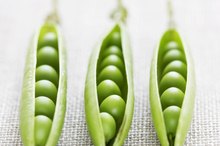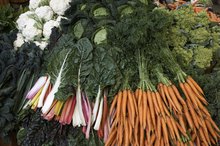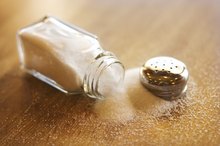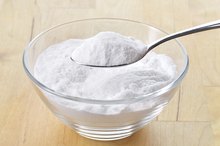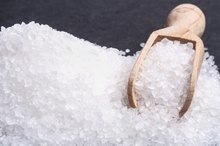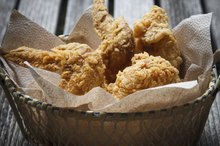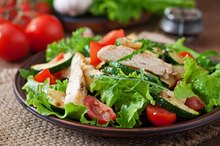What does fact checked mean?
At Healthfully, we strive to deliver objective content that is accurate and up-to-date. Our team periodically reviews articles in order to ensure content quality. The sources cited below consist of evidence from peer-reviewed journals, prominent medical organizations, academic associations, and government data.
The information contained on this site is for informational purposes only, and should not be used as a substitute for the advice of a professional health care provider. Please check with the appropriate physician regarding health questions and concerns. Although we strive to deliver accurate and up-to-date information, no guarantee to that effect is made.
A Low Sodium 1800-Calorie Diet
Consuming too much sodium can exacerbate certain health conditions, increasing your risk of developing heart disease. The USDA 2010 Dietary Guidelines for Americans notes that the average American consumes 3,400 mg of sodium per day, and that over one-half the population would benefit from reducing this intake to 1,500 mg or less per day 1. If you are following an 1,800-calorie diet for weight loss or maintenance, follow some simple strategies to keep your sodium intake in check.
Significance
While your body needs some sodium to support basic function, you do not need large quantities. A higher sodium intake usually correlates to higher blood pressure levels. High blood pressure increases your risk of heart disease and kidney disease. The USDA recommends that Americans consume no more than 2,300 mg of sodium per day and that people with hypertension, diabetes or chronic kidney disease, who are older than 51-years-old or are of African-American descent limit sodium to just 1,500 mg per day. While you are counting calories to consume just 1,800 per day, it may seem challenging to also keep track of your sodium intake.
- While your body needs some sodium to support basic function, you do not need large quantities.
Foods to Include
How to Lower Sodium Levels in the Blood Naturally
Learn More
Lean beef, fish, eggs and poultry are low-sodium sources of protein, which are low in saturated fat and fit into a healthy 1,800-calorie plan. You also want to emphasize fresh, unsauced vegetables and fruits that offer vitamins, minerals and antioxidants with minimal sodium. Whole grains, especially those without added seasoning, are important sources of fiber and B-vitamins. The fiber in these grains can help you feel full and satisfied while following an 1,800-calorie plan. Plant oils, unsalted nuts and avocados offer essential unsaturated fats to further support heart health, without adding sodium to your plan. Flavor foods with citrus, vinegar, herbs and salt-free seasoning mixes.
- Lean beef, fish, eggs and poultry are low-sodium sources of protein, which are low in saturated fat and fit into a healthy 1,800-calorie plan.
Foods to Avoid
Cured meats, canned soup, canned vegetables, frozen vegetables with sauce, prepared meals and fast foods tend to be high in sodium. Fast food and restaurant foods are also very high in sodium. Preparing meals at home often means you can control sodium content and calories. If you choose canned beans, rinse them before use to reduce the sodium content. Check labels on prepared bread, even whole-wheat varieties, which can also be high in added sodium.
- Cured meats, canned soup, canned vegetables, frozen vegetables with sauce, prepared meals and fast foods tend to be high in sodium.
- If you choose canned beans, rinse them before use to reduce the sodium content.
Sample Plan
What Can You Eat on a Low-Oxalate, Low-Sodium, Low-Protein Diet?
Learn More
An 1,800-calorie plan with just below 1,400 mg of sodium begins with an egg scrambled with 2 egg whites, 2 slices of whole-wheat toast, 8 oz. of skim milk and a glass of orange juice for breakfast. As a mid-morning snack, enjoy 1 oz. of almonds with 1 cup of non-fat, plain yogurt and a banana. For lunch, make a large salad with 3 oz. of roasted chicken breast, 2 cups of shredded romaine lettuce, chopped tomatoes and red bell pepper strips. Dress with 1 tbsp. of olive oil and the juice of one lemon and have an apple for dessert. Mid-afternoon, enjoy 1 oz. of part-skim mozzarella cheese and a serving of low-sodium saltine crackers. For dinner, broil 4 oz. of salmon and serve with ¼ cup of dry quinoa cooked with water, chopped onions and ½ cup of sliced mushrooms. Have 1 cup of fresh, steamed green beans on the side.
- An 1,800-calorie plan with just below 1,400 mg of sodium begins with an egg scrambled with 2 egg whites, 2 slices of whole-wheat toast, 8 oz.
- of almonds with 1 cup of non-fat, plain yogurt and a banana.
Related Articles
References
- U.S. Department of Agriculture; Dietary Guidelines for Americans; Chapter 3: Foods and Food Components to Reduce; 2010
- Cleveland Clinic: Low-Sodium Diet Guidelines
- American Heart Association. Sources of Sodium.
- Centers for Disease Control and Prevention. Top 10 Sources of Sodium. 2017.
- Institute of Medicine. Dietary Reference Intakes Tables and Application. National Academies of Sciences, Engineering, and Medicine, Health and Medicine Division. 2015.
- United States Department of Agriculture. Dietary Guidelines for Americans 2015–2020. United States Department of Health and Human Services. 2015.
Writer Bio
Andrea Boldt has been in the fitness industry for more than 20 years. A personal trainer, run coach, group fitness instructor and master yoga teacher, she also holds certifications in holistic and fitness nutrition.

